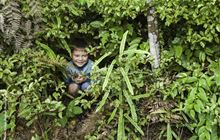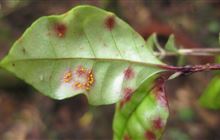Mānuka/kahikātoa and kānuka
Introduction
Although mānuka/kahikātoa and kānuka have a superficial similarity and are collectively known as ‘tea trees’ they are genetically very distinct from each other.Mānuka or kahikātoa (Leptospermum scoparium), called ‘tea tree’ by Captain Cook, is a rather variable plant ranging from flat creeping forms and small shrubs to tall trees (up to 10 m tall).
Although variable, all the forms of this species are unified by their sharp-tipped leaves, large, solitary white or pink-flushed flowers, with distinctive short, dark red stamens, and persistent greyish-white nut-like capsules. Mānuka/kahikātoa plants are sometimes covered with sooty mould, a black fungus that feeds on the honeydew produced by scale insects.
Kānuka (Kunzea ericoides), although superficially similar to mānuka, is a rather different plant. In its typical form it can grow into a tree up to 30 m tall. The trunk and branches are usually clad in long, leathery strips of bark, rather than the short, papery, rather flaky brown bark typical of the tree forms of mānuka/kahikātoa. Kānuka leaves lack the sharp tip of mānuka/kahikātoa. The flowers of this species are usually solitary but occur in clusters. The capsules of kānuka split open to release their seeds.
Recent research has confirmed that kānuka is endemic to New Zealand.
Where are they found?
Mānuka/kahikātoa is common throughout the North, South and Stewart Islands in lowland to low alpine regions up to 1800 m above sea level. It can be found in many different habitats including wetlands, river gravels and dry hillsides. When mature, it is very tolerant of drought, waterlogging, strong winds and frost and it can grow at less fertile, colder, wetter and more acidic sites than kānuka.
With the notable exception of Taranaki, kānuka is common throughout lowland and mountain scrub and along forest margins of the North and South Islands from the Three Kings Islands to about Kawarau Gorge and Dunedin in Otago. It is not found naturally south of there. The species has a wide range of tolerances and has been found growing around active geothermal systems. It can be found from sea level to 1800 metres.It grows well on all soil types except water-logged soils, and is tolerant of wind, drought and frost.
Facts
- Early settlers battled hard to clear their land and regarded mānuka/kahikātoa and kānuka as invasive shrubs that undid all of their hard work. Today however, these plants can act as an important tool for re-vegetating bare, eroded slopes. By creating shade and shelter from the wind, they provide an excellent nursery for other, slower growing native plants. Then, as these other plants get taller and overtop them, the mānuka/kahikātoa and kānuka die away as a result of being shaded.
- Unlike many other native plants, mānuka/kahikātoa and kānuka are not usually eaten by browsing animals like sheep, cattle and goats. This is another reason that these plants are useful in restoration projects.
- The hard, red wood of mānuka/kahikātoa was widely used by Māori for everything from paddles, weapons, spade blades, bird spears and mauls to house building. The bark was used for making water containers and the inner bark as a waterproof layer for roofing.
- Captain Cook and early settlers called mānuka/kahikātoa ‘tea tree’ because they used the green leaves to make a substitute for tea. They also brewed twigs from this plant with rimu to make beer.
- Mānuka/kahikātoa flowers smell very sweet and they provide an important source of pollen and nectar for native bees, flies, moths, beetles and geckos.
Did you know?
Chemical tests have shown that mānuka/kahikātoa pollen, and honey derived from it, contains powerful insecticides and anti-bacterial agents that can help fight intestinal worms and bacterial infections. Mānuka/kahikātoa oil is now sold in New Zealand and overseas in various cosmetics and health care products.
Threats
Both these plants are still widespread and common throughout New Zealand. However, they are often considered unwanted scrub and are burned or poisoned in order to clear land for pasture. Removing kānuka and mānuka/kahikātoa often eliminates the potential for further forest regeneration.
A taxonomic revision of kānuka nearing completion suggests that the New Zealand K. ericoides is divisible into 11 entities. One of these, currently known as Kunzea ericoides var. linearis is inadequately protected and is seriously threatened in large parts of its range by inbreeding with other kānuka varieties, habitat loss and the widespread use of it for firewood.
One other entity, currently known as K. ericoides var. microflora is endemic to geothermal systems of the Taupo volcanic zone, while a third, as yet unnamed species is confined to a remnant dune system near Whakatane.
Mānuka/kahikātoa (Leptospermum scoparium) is more variable but it has been little studied from a taxonomic viewpoint. Unlike kānuka, our mānuka/kahikātoa is present in Tasmania. Further research may find that New Zealand mānuka/kahikātoa should be divided into a number of species or sub-species.
You can help
Do not collect kānuka and mānuka/kahikātoa for use as firewood.
You can help forest regeneration by volunteering your time to help with a local planting day, or start your own little patch of bush by planting kānuka and mānuka/kahikātoa as a nurse crop.
Because both species are so variable, it is wise to plant only a locally sourced form. It would be better to avoid using commercial nursery material if planting into gardens abutting indigenous forest remnants.


